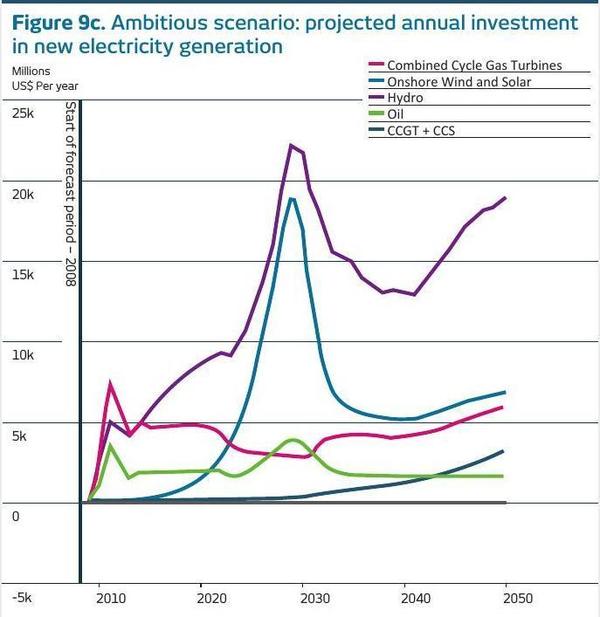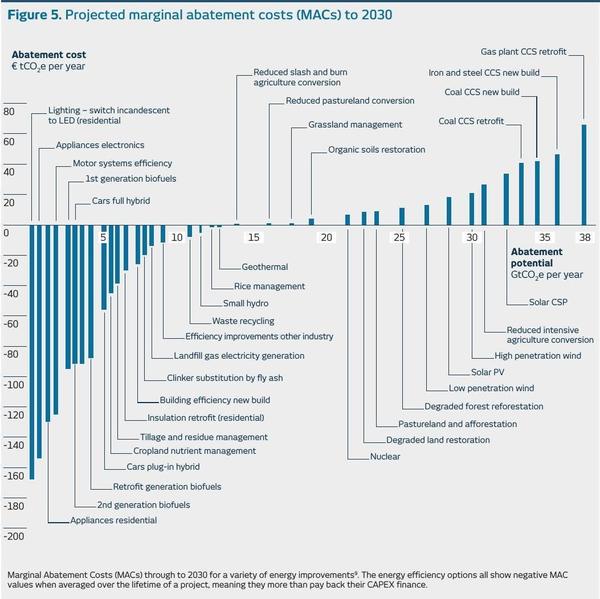A Middle East bank says:
Renewables accounted for 57 per cent of global power investment in new generation in the period 2000-2013.
And that’s even with all the legal and financial roadblocks thrown up by entrenched fossil fuel companies and electric utilities. The report recommends aligning policy and finance:
To deliver a sustainable energy system for the long term, the financial community and policymakers need to work collaboratively: stimulating and de-risking investment, and developing innovative structures which can support the financing of future energy.
With that collaboration, the Middle East and North Africa could
see this kind of energy deployment scenario:

Note that blue exponential curve for solar power for more than a decade, until about 2028, when presumably the bank report writers think the market for electricity there will mostly be saturated.
But why wait?
We do not need to wait for the required technologies to appear. Low carbon, sustainable technologies are already on the market, with costs that are dropping rapidly as the industry matures and grows. They are already market-tested and cost effective, especially for solar PV and on-shore wind. This situation is robust against changes in the price of oil.
Anastasia Pantsios, Ecowatch, 5 March 2015, Oil Can’t Compete With Renewables, Says National Bank of Abu Dhabi: Returns on fossil fuel investments aren’t keeping up with solar and wind, and are less likely to do so in the future, says bank report,
Energy demand is expected to triple in the next 15 years in the rapidly growing Persian Gulf region — already the biggest energy consumer per capita in the world — a demand far outstripping the current supply. Yet, despite the recent plunge in oil prices, the report says that that demand will be more efficiently filled by renewables, offering more reliable and lucrative investment opportunities than oil.
“Some of the report’s findings may surprise you, as they did me,” writes NBAD CEO Alex Thursby in the report’s introduction. “For example, renewable energy technologies are far further advanced than many may believe: solar photovoltaic (PV) and on-shore wind have a track record of successful deployment, and costs have fallen dramatically in the past few years. In many parts of the world, indeed, they are now competitive with hydrocarbon energy sources. Already, more than half of the investment in new electricity generation worldwide is in renewables. Potentially, the gains to be made from focusing on energy efficiency are as great as the benefits of increasing generation. Together, these help us to reframe how we think about the prospects for energy in the region.”
Among the report’s surprising findings are that fossil fuels are already uncompetitive with solar in terms of price, and that would be true even if oil fell as low as $10 a barrel. And with the supply of fossil fuels finite and increasingly difficult to extract, the bank believes that almost all future investments will be in renewables.
“Prices have fallen dramatically in the past few years: solar PV falling by 80 percent in six years, and on-shore wind by 40 percent,” it says. “The speed of this shift towards grid parity with fossil fuels means that, in many instances, perceptions of the role of renewables in the energy mix have not caught up with reality.”
The actual report, “Financing the Future of Energy: The opportunity for the Gulf’s financial services sector”, also harps on this:
Cost of energy efficiency is less than half the cost of increasing energy production
And again:
Industrial applications of energy efficiency can deliver 100 per cent payback in five years.
Here’s an illustration that the single most cost-effective energy investment is switching to LED lighting, followed by efficiency of appliances, motors, and vehicles, including hybrid vehicles.
Note the numerous cost-effective agricultural items, including organic soils restoration and reforestation, all more cost-effective than any new energy production.
The figure obviously isn’t perfect, because it includes biofuels, which are a great way to degrade land, and nuclear, without the numerous costs such as spent fuel storage. But it nonetheless gives an interesting spectrum.
Finally, writing about the Middle East, North Africa, and Asia:
For the economies along this corridor, there is a huge opportunity to leapfrog traditional approaches to developing energy systems, moving immediately to cutting edge technologies, more cost-efficient and decentralised systems, and applying more innovative approaches to finance these developments.
Here in the sunny U.S. southeast, at the same latitude as North Africa and with similar issues of poor rural populations, there’s no reason we can’t leapfrog as well, and profit by doing so.
-jsq
Short Link:
